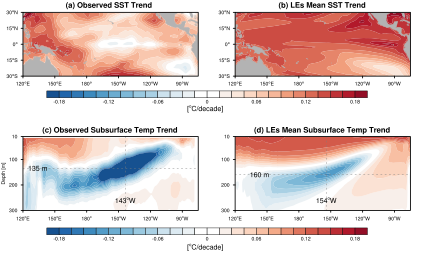Why tropical Pacific subsurface cooling doesn't surface in climate models
Despite rising greenhouse gas concentrations, sea surface temperature (SST) in the eastern equatorial Pacific has shown little to no warming since the mid-20th century. The peculiar cold tongue response and the associated strengthening of the zonal SST gradient stand in stark contrast to most climate model simulations, which typically simulate enhanced warming in the east and a weakening of the zonal SST gradient. Understanding this discrepancy is critical for improving projections of tropical Pacific climate and its global teleconnections.
Jiang et al. (2025), examining long-term trends over 1958 to 2022, identifies a key reason for the mismatch: models fail to generate subsurface cooling through realistic wind-driven circulation changes or to effectively communicate that cooling to the surface through upwelling and mixing. Although both observations and models feature subsurface cooling in the equatorial Pacific under historical radiative forcing, only in observations does this cooling effectively shape SST trends (Figure 1). In the real world, subsurface cooling is relatively shallow and located farther east, where strong climatological upwelling and vertical mixing efficiently transmit its influence to the surface. In contrast, in most models, subsurface cooling occurs deeper and farther west, making it less effective at cooling SST. The models that most closely reproduce the observed SST trend patterns tend to simulate subsurface cooling that mirrors the observed spatial structure, though its magnitude is significantly underestimated. However, even these models produce the correct sign of the SST gradient trend for the wrong reasons. Rather than capturing equatorial dynamics as observed, they simulate a strengthening of the zonal SST gradient as a consequence of unrealistic interhemispheric warming contrasts that generate erroneous cross-equatorial wind patterns. Another important factor is the representation of upper ocean stability. In most models, the erroneous surface warming increases stratification and suppresses vertical mixing significantly more than observed, weakening the connection between thermocline cooling and SST pattern.
This study highlights that what matters for SST pattern formation over the equatorial Pacific is not simply the existence of subsurface cooling in simulations, but how it is generated, where it occurs, and whether it can reach the surface. Without accurately representing both the drivers and vertical connectivity of subsurface cooling, models will continue to misrepresent the tropical Pacific response to radiative forcing.

Figure 1. Trend in SST and subsurface temperature for observation and Large Ensemble (LE) simulations. (a) Composited equatorial (5S~5N) SST trend (/decade) during 1958-2022 based on HadISST, ERSSTv5, COBE, and Kaplan. (b) Composited equatorial forced SST trend (/decade) across 11 LEs (Table S1). (c) Composited equatorial subsurface temperature trend (/decade) based on ORAs5 (1958-2022), SODA2.2.4 (1958-2008), Ishii (1958-2012), and EN4 (1958-2022). (d) Composited equatorial forced subsurface temperature trend (/decade) across 11 LEs. The dashed lines in (c) and (d) indicate the depth and longitude of the maximum subsurface cooling.
Subsurface Cooling and Sea Surface Temperature Pattern Formation Over the Equatorial Pacific (JGR Oceans)
Topics
- Modeling
- Pacific Ocean
